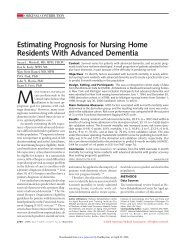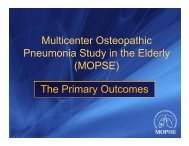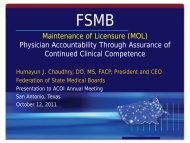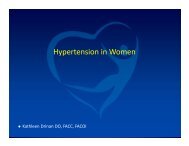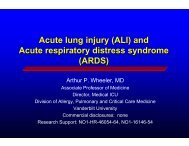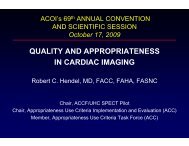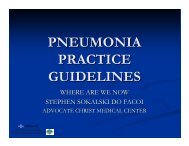Evidence-Based Palliative Care In The ICU
Evidence-Based Palliative Care In The ICU
Evidence-Based Palliative Care In The ICU
Create successful ePaper yourself
Turn your PDF publications into a flip-book with our unique Google optimized e-Paper software.
<strong>Evidence</strong>-<strong>Based</strong> <strong>Palliative</strong><br />
<strong>Care</strong> <strong>In</strong> <strong>The</strong> <strong>ICU</strong><br />
Dominic F Glorioso Jr DO FACOI<br />
San Antonio, Texas<br />
October 13, 2011
Objectives<br />
1. Discuss the origins of palliative care and the <strong>ICU</strong><br />
2. Describe what kinds of problems <strong>ICU</strong>s have that<br />
may benefit from palliative care<br />
3. Discuss the different models involving palliative<br />
care and the <strong>ICU</strong><br />
4. List the benefits of collaboration<br />
5. Explore “non-palliative care” literature to explain<br />
these objectives<br />
York Hospital <strong>Palliative</strong> <strong>Care</strong>
“I don't want to<br />
achieve immortality<br />
through my work,<br />
I want to achieve it<br />
through not dying.”<br />
Woody Allen<br />
US movie actor, comedian, & director (1935 - )
“<strong>In</strong> principle, people want a<br />
peaceful, dignified, comfortable<br />
death but … in reality, they do<br />
not want it quite yet. <strong>The</strong>y prefer<br />
life-prolonging care in the hope<br />
that their peaceful, dignified<br />
death can occur later.… We will<br />
[not] achieve more comfortable<br />
or peaceful deaths by trying to<br />
persuade our patients that<br />
comfort care is their best<br />
option when they still have what many perceive as<br />
reasonable odds for longer survival. We will have an impact<br />
only when we assiduously treat the uncomfortable<br />
symptoms of all seriously ill patients, whether they are<br />
receiving life prolonging care with its treatment-induced<br />
discomforts or only palliative care.”<br />
Ainslie. Ann <strong>In</strong>tern Med 1997.
“<strong>In</strong> principle, people want a<br />
peaceful, dignified, comfortable<br />
death but … in reality, they do<br />
not want it quite yet. <strong>The</strong>y prefer<br />
life-prolonging care in the hope<br />
that their peaceful, dignified<br />
death can occur later.… We will<br />
[not] achieve more comfortable<br />
or peaceful deaths by trying to<br />
persuade our patients that<br />
comfort care is their best<br />
option when they still have what many perceive as<br />
reasonable odds for longer survival. We will have an impact<br />
only when we assiduously treat the uncomfortable<br />
symptoms of all seriously ill patients, whether they are<br />
receiving life prolonging care with its treatment-induced<br />
discomforts or only palliative care.”<br />
Ainslie. Ann <strong>In</strong>tern Med 1997.
Death and Dying in America<br />
Disparity between the way people die / the way<br />
they want to die<br />
• Most prefer to be cared for at home<br />
• Majority interested in a program such as<br />
hospice<br />
York Hospital <strong>Palliative</strong> <strong>Care</strong>
“Doctor, I Want Everything ”
Types of <strong>In</strong>tensive<br />
<strong>Care</strong> Units<br />
•Medical <strong>ICU</strong><br />
•Surgical <strong>ICU</strong><br />
•MTCU<br />
•STCU<br />
•Cardiac <strong>ICU</strong><br />
What the hell<br />
am<br />
I doing<br />
here <br />
•Trauma <strong>ICU</strong><br />
•Open Heart <strong>ICU</strong><br />
•Pediatric <strong>ICU</strong><br />
•Neonatal <strong>ICU</strong><br />
•Burn <strong>ICU</strong><br />
York Hospital <strong>Palliative</strong> <strong>Care</strong>
What Is <strong>ICU</strong> Medicine<br />
We can cure anyone<br />
Death is failure<br />
Failure is not an option<br />
When in doubt, do more tests<br />
When really in doubt, order another<br />
consult<br />
We are right often, wrong<br />
occasionally, but never in doubt<br />
York Hospital <strong>Palliative</strong> <strong>Care</strong>
What is <strong>Palliative</strong> care<br />
Euthanasia<br />
Physician assisted suicide<br />
Giving up<br />
Discontinuing care<br />
Morphine drips<br />
Last 24 - 48 hours<br />
Death squads<br />
York Hospital <strong>Palliative</strong> <strong>Care</strong>
Traditional Dichotomous<br />
Paradigm:<br />
Why can’t we<br />
be friends<br />
York Hospital <strong>Palliative</strong> <strong>Care</strong>
Traditional Dichotomous<br />
Paradigm:<br />
“Do everything” until “there is nothing more to<br />
be done" and then give “comfort care only”<br />
vs.<br />
<strong>Palliative</strong> <strong>Care</strong> initiated at the time of diagnosis,<br />
independent of prognosis, and delivered in<br />
concert with curative / life-extending efforts<br />
York Hospital <strong>Palliative</strong> <strong>Care</strong>
What Is <strong>Palliative</strong> <strong>Care</strong><br />
Standard <strong>Care</strong><br />
<strong>Palliative</strong> <strong>Care</strong><br />
York Hospital <strong>Palliative</strong> <strong>Care</strong><br />
Life
“I see dead people!”<br />
York Hospital <strong>Palliative</strong> <strong>Care</strong>
<strong>The</strong> Old "Exhaustion" Model<br />
• <strong>ICU</strong> care involves multiple specialists who<br />
provide support for a particular defined organ<br />
system<br />
• <strong>In</strong>tervene in each crisis with a goal to support<br />
life until all options are exhausted<br />
• <strong>ICU</strong> stays may stretch to weeks or months<br />
with each new complication or crisis being<br />
addressed and managed<br />
• <strong>The</strong> palliative care referral, if there is one,<br />
occurs when treatment options, insurance<br />
benefits, or finances are exhausted<br />
York Hospital <strong>Palliative</strong> <strong>Care</strong>
Case 1<br />
62 year old female, with a history of<br />
substance abuse, wanders into traffic and is<br />
struck by a truck. After one month in the trauma<br />
unit, she has never been alert.<br />
She is on the ventilator and is<br />
showing signs of hepatic failure<br />
and sepsis. She is also going<br />
into renal failure, and you<br />
need to decide if dialysis<br />
should be started.<br />
York Hospital <strong>Palliative</strong> <strong>Care</strong>
<strong>ICU</strong> Costs<br />
• Adult patients on prolonged acute mechanical<br />
ventilation (PAMV) comprise 1/3 of all adult<br />
MV patients<br />
• Consume 2/3 of hospital resources allocated<br />
to MV population<br />
• Are nearly twice as likely to require a<br />
discharge to a skilled nursing facility (SNF )<br />
• <strong>The</strong>ir numbers are projected to double by year<br />
2020<br />
York Hospital <strong>Palliative</strong> <strong>Care</strong><br />
BMC Health Serv Res. 2008; 8: 242.
National Healthcare Expenditures<br />
as a Share of GDP<br />
York Hospital <strong>Palliative</strong> <strong>Care</strong>
What <strong>Palliative</strong> <strong>Care</strong> is NOT<br />
• A mutually exclusive alternative to lifeprolonging,<br />
restorative care<br />
• A way to “periodically cleanse the hospital of<br />
its long stay outliers”<br />
York Hospital <strong>Palliative</strong> <strong>Care</strong>
What Is <strong>Palliative</strong> <strong>Care</strong><br />
Standard<br />
Standard<br />
<strong>Care</strong><br />
<strong>Care</strong><br />
<strong>Palliative</strong> <strong>Care</strong><br />
York Hospital <strong>Palliative</strong> <strong>Care</strong><br />
Life
What Is <strong>Palliative</strong> <strong>Care</strong><br />
Standard<br />
<strong>Care</strong><br />
<strong>Palliative</strong> <strong>Care</strong><br />
Standard <strong>Care</strong><br />
York Hospital <strong>Palliative</strong> <strong>Care</strong><br />
Life
York Hospital <strong>Palliative</strong> <strong>Care</strong><br />
Balfour Mount MD
What Is <strong>Palliative</strong> <strong>Care</strong><br />
<strong>The</strong> term ‘‘palliative care’’ was coined by a<br />
surgeon, Balfour Mount, in the context of<br />
introducing the hospice concept to the Royal<br />
Victoria Hospital, an acute care multi-specialty<br />
hospital in Montreal.<br />
York Hospital <strong>Palliative</strong> <strong>Care</strong>
What Is <strong>Palliative</strong> <strong>Care</strong><br />
“<strong>Palliative</strong> care seeks to prevent, relieve, reduce<br />
or soothe the symptoms of diseases or<br />
disorders without effecting cure…<br />
York Hospital <strong>Palliative</strong> <strong>Care</strong>
What Is <strong>Palliative</strong> <strong>Care</strong><br />
<strong>Palliative</strong> care may be needed at any time in the<br />
disease trajectory and bereavement.<br />
York Hospital <strong>Palliative</strong> <strong>Care</strong>
What Is <strong>Palliative</strong> <strong>Care</strong><br />
It may be combined with therapies aimed at<br />
reducing or curing the illness, or it may be the<br />
total focus of care. <strong>Care</strong> is delivered through the<br />
collaboration efforts of an interdisciplinary team<br />
including the individual, family and others involved in<br />
the provision of care. Where possible, the palliative<br />
care should be available in the setting of personal<br />
choice.”<br />
Balfour Mount MD, McGill University, Director of the Royal Victorian Hospital,<br />
<strong>Palliative</strong> <strong>Care</strong> Center<br />
York Hospital <strong>Palliative</strong> <strong>Care</strong>
What Is <strong>ICU</strong> Medicine<br />
<strong>In</strong>tensive-care medicine or critical-care<br />
medicine is a branch of medicine concerned<br />
with the provision of life support or organ<br />
support systems in patients who are critically<br />
ill and who usually require intensive monitoring<br />
From Wikipedia, the free encyclopedia<br />
York Hospital <strong>Palliative</strong> <strong>Care</strong>
What Is <strong>ICU</strong> Medicine<br />
1. <strong>The</strong> <strong>ICU</strong>'s roots can be traced<br />
back to the Monitoring Unit of<br />
critical patients through nurse<br />
Florence Nightingale (1820-<br />
1910).<br />
2. Because of the lack of critical<br />
care and the high rate of<br />
infection, there was a high<br />
mortality rate of hospitalized<br />
soldiers.<br />
3. Upon arriving and practicing,<br />
the mortality rate fell to 2%.<br />
York Hospital <strong>Palliative</strong> <strong>Care</strong>
What Is <strong>ICU</strong> Medicine<br />
1. Bjørn Aage Ibsen (1915–2007)<br />
He became involved in the 1952<br />
poliomyelitis outbreak in<br />
Denmark.<br />
2. Ibsen changed management<br />
directly, instituting protracted<br />
positive pressure ventilation by<br />
means of intubation into the<br />
trachea.<br />
3. Patients were managed in 3<br />
special 35 bed areas, which<br />
aided charting and other<br />
management.<br />
York Hospital <strong>Palliative</strong> <strong>Care</strong>
What Is <strong>ICU</strong> Medicine<br />
1. Peter Safar (1924-2003) was<br />
the first <strong>In</strong>tensivist doctor in the<br />
USA.<br />
2. <strong>In</strong> the 1950s, he started the<br />
"Urgency & Emergency" room<br />
setup (now known as an <strong>ICU</strong>).<br />
3. It was at this time the ABC<br />
(Airway, Breathing, and<br />
Circulation) protocols were<br />
formed.<br />
York Hospital <strong>Palliative</strong> <strong>Care</strong>
What Is <strong>ICU</strong> Medicine<br />
1. Doctors, nurses and other<br />
health care professionals with<br />
special training<br />
2. <strong>The</strong> use of special devices and<br />
technology for the care of such<br />
patients<br />
3. Specialized areas in the<br />
hospital for critically ill patients<br />
York Hospital <strong>Palliative</strong> <strong>Care</strong>
What Is <strong>ICU</strong> Medicine<br />
<strong>In</strong>tensive-care medicine or critical-care<br />
medicine is a branch of medicine concerned<br />
with the provision of life support or organ support<br />
systems in patients who are critically ill and<br />
who usually require intensive monitoring.<br />
York Hospital <strong>Palliative</strong> <strong>Care</strong>
What Is <strong>ICU</strong> Medicine<br />
• Approximately 20% of deaths in the United<br />
States occur in an intensive care unit (<strong>ICU</strong>) or<br />
shortly after a stay in the <strong>ICU</strong><br />
• <strong>The</strong> majority of deaths in the <strong>ICU</strong> are preceded<br />
by a decision to withhold or withdraw lifesustaining<br />
therapies<br />
• <strong>The</strong>re is considerable evidence of problems in<br />
the quality of care these patients and their<br />
families receive<br />
York Hospital <strong>Palliative</strong> <strong>Care</strong>
Where We Die<br />
York Hospital <strong>Palliative</strong> <strong>Care</strong><br />
Angus et al. Crit <strong>Care</strong> Med 2004; 32:638.
<strong>The</strong> SUPPORT Study<br />
• $28 million study, 5 Medical Centers, 10 years<br />
• 4301 patients observed to determine terminally-ill<br />
patients base-line experiences during the dying<br />
process<br />
• Less than 50% of physicians knew whether their<br />
patients wanted CPR or not<br />
• 50% of patients who died in the hospital, the family<br />
reported that the patient had moderate to severe pain<br />
at least half of their stay<br />
York Hospital <strong>Palliative</strong> <strong>Care</strong><br />
Study to Understand Prognoses and<br />
Preferences for Outcomes and Risks of<br />
Treatments
Management of Pain in Cardiac<br />
Surgery <strong>ICU</strong> Patients: Have We<br />
Improved Over Time<br />
Amazing Results!<br />
1. Patients were 10 times as likely to remember<br />
having an ET tube and its removal then if they<br />
had any visitors (50% vs. 5%).<br />
2. Most reported that the pain was in there chest<br />
(duh!) and was made worse when they were<br />
turned.<br />
3. 75% reported that there pain was moderate to<br />
severe!<br />
York Hospital <strong>Palliative</strong> <strong>Care</strong>
Pain Management Within the<br />
<strong>Palliative</strong> and End-of-Life <strong>Care</strong><br />
Experience in the <strong>ICU</strong><br />
1. All <strong>ICU</strong> patients experience pain and discomfort regardless<br />
of prognosis or goals.<br />
2. For those dying in the <strong>ICU</strong>, a shift to comfort care goals<br />
may be the most beneficial treatment.<br />
3. Communication and cultural sensitivity with the patientfamily<br />
unit is important for comprehensive <strong>ICU</strong> care.<br />
York Hospital <strong>Palliative</strong> <strong>Care</strong>
Pain Management Within the<br />
<strong>Palliative</strong> and End-of-Life <strong>Care</strong><br />
Experience in the <strong>ICU</strong><br />
4. Ethical, (medical) and legal misconceptions about the<br />
escalation of opiates should not be barriers to<br />
appropriate care.<br />
5. Standardized instruments, performance measurement<br />
and care delivery aids are effective strategies for<br />
improving palliative care.<br />
6. <strong>Palliative</strong> care should address family and caregiver<br />
stress associated with caring for critically ill patients and<br />
anticipated suffering and loss.<br />
York Hospital <strong>Palliative</strong> <strong>Care</strong>
Important Opportunities<br />
for Improvement<br />
• Untreated pain and other distressing symptoms<br />
• Failure to address other patient/family needs<br />
• Poor communication that compromises decision<br />
making and worsens the patient/family experience<br />
• Conflict among clinicians/patients/families<br />
• Divergence of treatment goals from pt/family<br />
preferences<br />
• Delay in implementation of appropriate care plans<br />
• Use of therapies with burdens > benefits<br />
York Hospital <strong>Palliative</strong> <strong>Care</strong>
What is <strong>Palliative</strong> <strong>Care</strong><br />
<strong>Care</strong> for patients and families facing serious and<br />
complex illness, focused on:<br />
• Alleviation of distress<br />
• Communication about treatments and care goals<br />
• Alignment of plan with preferences<br />
• Smooth and continuous transitions across<br />
settings<br />
• Provided simultaneously with medical treatment<br />
for cure, disease-modification, life-prolongation<br />
York Hospital <strong>Palliative</strong> <strong>Care</strong>
What is <strong>Palliative</strong> <strong>Care</strong><br />
• <strong>In</strong>corporated in comprehensive critical care for<br />
all patients, including those pursuing lifeprolonging<br />
treatments<br />
• Not simply a sequel to failed intensive care,<br />
but a synchronous, synergistic, component of<br />
<strong>ICU</strong> treatment<br />
York Hospital <strong>Palliative</strong> <strong>Care</strong>
<strong>ICU</strong>-<strong>Palliative</strong> <strong>Care</strong> Models<br />
Consultative Model<br />
<strong>In</strong>tegrative Model<br />
<strong>Palliative</strong> <strong>Care</strong><br />
Team<br />
<strong>Palliative</strong> <strong>Care</strong><br />
Consultation<br />
<strong>Palliative</strong> <strong>Care</strong><br />
Principles/<strong>In</strong>terventions<br />
Embedded in Usual<br />
<strong>ICU</strong> <strong>Care</strong><br />
Usual <strong>ICU</strong><br />
<strong>Care</strong> By Critical<br />
<strong>Care</strong> Team<br />
York Hospital <strong>Palliative</strong> <strong>Care</strong><br />
Crit <strong>Care</strong> Med 2010 Vol. 38, No. 9
<strong>In</strong>tegration by Critical<br />
<strong>Care</strong> Team - Advantages<br />
• Availability of palliative care for all <strong>ICU</strong> patients<br />
and families<br />
• <strong>Palliative</strong> care service not required<br />
• Clearly acknowledges importance of palliative care<br />
as core element of intensive care<br />
• Systematization of <strong>ICU</strong> work processes promotes<br />
reliable performance of palliative care<br />
York Hospital <strong>Palliative</strong> <strong>Care</strong>
<strong>In</strong>tegration by Critical<br />
<strong>Care</strong> Team - Disadvantages<br />
•Requires education of <strong>ICU</strong> clinicians in palliative<br />
care knowledge and skills<br />
•Depends on commitment of critical care clinicians<br />
and supportive <strong>ICU</strong> culture<br />
•Requires dedication of staff and other resources<br />
that may be lacking in <strong>ICU</strong><br />
•Requires handoff to new team for post-<strong>ICU</strong><br />
palliative care for patients who cannot benefit from<br />
or no longer need the <strong>ICU</strong><br />
York Hospital <strong>Palliative</strong> <strong>Care</strong>
Consultation by PC<br />
Service –Advantages<br />
• Expert input from interdisciplinary team of specialists<br />
• Expertise already exists, additional training unnecessary<br />
• Empirical evidence of benefit<br />
• Continuity of care before, during and after <strong>ICU</strong><br />
• Facilitation of transfer out of <strong>ICU</strong> for end-of-life care, if<br />
appropriate<br />
York Hospital <strong>Palliative</strong> <strong>Care</strong>
Consultation by PC<br />
Service –Disadvantages<br />
• Requires palliative care service with adequate staffing<br />
and other resources<br />
• Consultants may lack familiarity with biomedical and<br />
nursing aspects of critical care, seen as “outsiders”<br />
• Consultants must rapidly establish effective relationship<br />
with patients/families<br />
• Fragmentation of care may be compounded<br />
• <strong>ICU</strong> team may have less incentive to improve palliative<br />
care knowledge and skills<br />
York Hospital <strong>Palliative</strong> <strong>Care</strong>
Domains to Measures: <strong>ICU</strong><br />
<strong>Palliative</strong> <strong>Care</strong> “Bundle”<br />
Day 1<br />
(1) Identify decision-maker<br />
(2) Address AD<br />
(3) Address CPR status<br />
(4) Distribute info leaflet<br />
(5) Assess pain regularly<br />
(6) Manage pain optimally<br />
By Day 3<br />
(7) Offer SW support<br />
(8) Offer spiritual support<br />
By Day 5<br />
(9) Family meeting<br />
York Hospital <strong>Palliative</strong> <strong>Care</strong>
<strong>ICU</strong> Communication<br />
IT’S A<br />
CREATININE FAN<br />
IS DOWN<br />
PLATELETS<br />
IT’S A<br />
ARE UP<br />
ROPE<br />
BP IT’S ISA<br />
BETTER SNAKE<br />
RHYTHM IT’S A<br />
TREE IS STABLE TRUNK<br />
IT’S IT’S A STILL PAIR<br />
OF A BOWLING PAIR OF<br />
BOWLING BALLS<br />
BALLS!!!<br />
York Hospital <strong>Palliative</strong> <strong>Care</strong>
Case 2<br />
50 Year old mentally retarded man comes<br />
into the hospital from the group home with a<br />
chief complaint of shortness of breath. His<br />
caretaker states he tried to swallow a hairpin.<br />
He is about to be placed on a ventilator, but his<br />
family arrives and states that<br />
he is a “no code.”<br />
York Hospital <strong>Palliative</strong> <strong>Care</strong>
Who Should Make<br />
End of Life Decisions<br />
<strong>The</strong> clergy<br />
<strong>The</strong> law<br />
<strong>The</strong> patient<br />
<strong>The</strong> doctor<br />
<strong>The</strong> family<br />
York Hospital <strong>Palliative</strong> <strong>Care</strong><br />
<strong>The</strong> Partner
Who Should Make<br />
End of Life Decisions<br />
<strong>The</strong> clergy<br />
<strong>The</strong> law<br />
<strong>The</strong> doctor<br />
<strong>The</strong> family<br />
York Hospital <strong>Palliative</strong> <strong>Care</strong><br />
<strong>The</strong> Partner
Comparative Effectiveness<br />
H.R.1<br />
Title: American Recovery and Reinvestment Act of 2009<br />
Sponsor: Rep Obey, David R.[WI-7]<br />
<strong>In</strong>troduced 1/26/2009 Cosponsors 9<br />
Latest Major Action: Became Public Law No: 111-5<br />
COSPONSORS(9):<br />
Rep Frank, Barney<br />
Rep Gordon, Bart<br />
Rep Miller, George<br />
Rep Oberstar, James<br />
Rep Spratt, John N, John M Rep Towns, Edolphus<br />
Rep Velazquez, Nydia M. Rep Waxman, Henry A.<br />
Rep Rangel, Charles<br />
York Hospital <strong>Palliative</strong> <strong>Care</strong>
Comparative Effectiveness<br />
<strong>In</strong> addition, $400,000,000 shall be available for comparative<br />
effectiveness research to be allocated at the discretion of the<br />
Secretary of Health and Human Services That the funding<br />
appropriated in this paragraph shall be used to accelerate the<br />
development and dissemination of research assessing the<br />
comparative effectiveness of health care treatments and<br />
strategies, through efforts that:<br />
(1) conduct, support, or synthesize research that compares the<br />
clinical outcomes, effectiveness, and appropriateness of items,<br />
services, and procedures that are used to prevent, diagnose, or<br />
treat diseases, disorders, and other health conditions; and<br />
(2) encourage the development and use of clinical registries,<br />
clinical data networks, and other forms of electronic health data<br />
that can be used to generate or obtain outcomes data<br />
York Hospital <strong>Palliative</strong> <strong>Care</strong>
Comparative Effectiveness<br />
<strong>In</strong> addition, $400,000,000 shall be available for comparative<br />
effectiveness research to be allocated at the discretion of the<br />
Secretary of Health and Human Services That the funding<br />
appropriated in this paragraph shall be used to accelerate the<br />
development and dissemination of research assessing the<br />
comparative effectiveness of health care treatments and<br />
strategies, through efforts that:<br />
(1) conduct, support, or synthesize research that compares the<br />
clinical outcomes, effectiveness, and appropriateness of items,<br />
services, and procedures that are used to prevent, diagnose, or<br />
treat diseases, disorders, and other health conditions; and<br />
(2) encourage the development and use of clinical registries,<br />
clinical data networks, and other forms of electronic health data<br />
that can be used to generate or obtain outcomes data<br />
York Hospital <strong>Palliative</strong> <strong>Care</strong>
Comparative Effectiveness:<br />
AOA Position<br />
• <strong>The</strong> AOA is confident that the growing<br />
emphasis on comparative effectiveness<br />
research bodes well for the osteopathic<br />
medical profession.<br />
• <strong>The</strong> AOA supports the concept of comparative<br />
effectiveness research, as long as the results<br />
are not used to control medical decisionmaking.<br />
• Any guidelines developed “should be advisory<br />
not mandatory.”<br />
York Hospital <strong>Palliative</strong> <strong>Care</strong>
Impact of Limiting Futile <strong>Care</strong><br />
Method of Medicare<br />
Reimbursement and the Rate<br />
of Potentially <strong>In</strong>effective <strong>Care</strong><br />
of Critically Ill Patients<br />
Daniel J. Cher MD; Leslie A.Lenhart MD, MS<br />
JAMA, September 24, 1997 – Vol 278, No. 12<br />
York Hospital <strong>Palliative</strong> <strong>Care</strong>
Impact of Limiting Futile <strong>Care</strong><br />
• Potentially ineffective care (PIC) was defined<br />
as in-hospital death or death within 100 days<br />
of discharge AND resource use above the 90 th<br />
percentile<br />
• Study looked at all California patients in 1994<br />
hospitalized in the <strong>ICU</strong>, 3914 met criteria for<br />
PIC<br />
• Compared patients enrolled in traditional<br />
Medicare costs versus those enrolled in HMO<br />
Medicare<br />
York Hospital <strong>Palliative</strong> <strong>Care</strong>
Impact of Limiting Futile <strong>Care</strong><br />
• PIC was less likely among HMO members<br />
versus non-HMO members (adjusted odds<br />
ratio 0.75; 95% confidence interval, 0.65<br />
versus 0.87<br />
• However, there as an 8% increase in 100 day<br />
mortality and a 9% increase in one year<br />
mortality<br />
York Hospital <strong>Palliative</strong> <strong>Care</strong>
Impact of Limiting Futile <strong>Care</strong><br />
Prognosis-based futility<br />
guidelines: does anyone win<br />
Teno JM, Murphy D, Lynn J, Tosteso A, Desbiens A,<br />
Connors AF Jr, Hamels MB, Wu A, Phillips R,<br />
Wenger N, et al.<br />
J AM Geriatr Soc.1994 Nov;42(11):1202-7.<br />
York Hospital <strong>Palliative</strong> <strong>Care</strong>
Impact of Limiting Futile <strong>Care</strong><br />
• 4301 patients, 115 (2.7%) had an estimated<br />
chance of 2-month survival of < or = 1%<br />
• All but one of these 115 subjects died within 6<br />
months<br />
• 86% died within 5 days of prognosis<br />
• A DNR order was written either before (n = 61)<br />
or within 5 days (n = 18) of reaching this<br />
prognosis for 68.6% of the patients<br />
• At the time of death, 92 subjects (80.0%) had<br />
had no attempt at resuscitation<br />
York Hospital <strong>Palliative</strong> <strong>Care</strong>
Impact of Limiting Futile <strong>Care</strong><br />
• <strong>The</strong>se 115 subjects had total hospital charges<br />
of $8.8 million<br />
• By forgoing or withdrawing life-sustaining<br />
treatment 199 of 1,688 hospital days (10.8%)<br />
would be forgone, with estimated savings of<br />
$1.2 million in hospital charges<br />
• Nearly 75% of the savings in hospital days<br />
would have resulted from stopping treatment<br />
for 12 patients, six of whom were under 51<br />
years old, and one of whom lived 10 months<br />
York Hospital <strong>Palliative</strong> <strong>Care</strong>
Impact of Limiting Futile <strong>Care</strong><br />
CONCLUSIONS:<br />
Patients at a high risk of dying can be identified<br />
prospectively. Implementation of a strict,<br />
prognosis-based futility guideline on the third<br />
day of a serious illness would result in modest<br />
savings<br />
York Hospital <strong>Palliative</strong> <strong>Care</strong>
York Hospital <strong>Palliative</strong> <strong>Care</strong>
Authentic Values & Real<br />
<strong>In</strong>terests: Step by Step<br />
1. Empathic connection<br />
2. Authentic values<br />
3. Clinical data<br />
4. Real <strong>In</strong>terests<br />
5. Clinical judgment<br />
6. Best judgment for the patient<br />
York Hospital <strong>Palliative</strong> <strong>Care</strong><br />
Sulmasy & Snyder, 2010, used with permission
1. Empathic Connection<br />
Clinician acknowledges<br />
the stresses of the<br />
situation & the difficulty of<br />
the task & attends to the<br />
needs of the surrogate<br />
“It must be very difficult to<br />
see your loved one so<br />
sick.”<br />
York Hospital <strong>Palliative</strong> <strong>Care</strong><br />
Sulmasy & Snyder, 2010, used with permission
2. Authentic Values<br />
Surrogate is asked to<br />
express an understanding<br />
of the patient as a person<br />
Values: interpersonal,<br />
moral, religious<br />
Directives: preferences<br />
regarding treatment, who<br />
decides, and how<br />
“Tell us about your loved<br />
one.”<br />
“Has anyone else in the<br />
family ever experienced a<br />
situation like this”<br />
York Hospital <strong>Palliative</strong> <strong>Care</strong><br />
Sulmasy & Snyder, 2010, used with permission
3. Clinical Data<br />
Clinician provides a<br />
shared understanding of<br />
the clinical circumstances<br />
and prognosis<br />
“Here is what is wrong.”<br />
“This is what is likely to<br />
happen.”<br />
York Hospital <strong>Palliative</strong> <strong>Care</strong><br />
Sulmasy & Snyder, 2010, used with permission
4. Real <strong>In</strong>terests<br />
Surrogate helps determine<br />
what the real interests of<br />
the patient might be, given<br />
the patient’s authentic<br />
values and given the<br />
clinical circumstances<br />
“Knowing your loved one,<br />
what do you think would<br />
be most important for him<br />
or her right now”<br />
York Hospital <strong>Palliative</strong> <strong>Care</strong><br />
Sulmasy & Snyder, 2010, used with permission
5. Clinical Judgment<br />
Clinician establishes a<br />
shared understanding of<br />
the options & offers a<br />
recommendation based on<br />
clinical experience & a<br />
community standard of<br />
reasonability, tailored to<br />
the patient’s real interests<br />
“Here’s what could be<br />
done.”<br />
“Here’s what we would<br />
recommend, based on<br />
what we know and what<br />
you’ve said about your<br />
loved one.”<br />
York Hospital <strong>Palliative</strong> <strong>Care</strong><br />
Sulmasy & Snyder, 2010, used with permission
6. Best judgment<br />
Together, determine what<br />
would best promote the good<br />
of the patient as a unique<br />
person, in the context of<br />
his/her relationships,<br />
authentic values, known<br />
wishes, & real interests,<br />
given the clinical<br />
circumstances & options<br />
“Knowing your loved one,<br />
does our recommendation<br />
seem right for him/her”<br />
“Do you think another plan<br />
would be better, given<br />
his/her values, preferences,<br />
and relationships”<br />
York Hospital <strong>Palliative</strong> <strong>Care</strong><br />
Sulmasy & Snyder, 2010, used with permission
Case 3<br />
n 87 year old female comes into the<br />
hospital after a fall, and has a witnessed<br />
cardiac arrest while still in the ED. CPR and<br />
the hypothermia protocol are started, but after<br />
three days in the <strong>ICU</strong>, she is on a ventilator,<br />
off sedation and unresponsive. Her son wants<br />
to have her removed from the<br />
ventilator, but her granddaughter<br />
does not want to “pull the plug.”<br />
York Hospital <strong>Palliative</strong> <strong>Care</strong>
Technological Support<br />
•Automatic internal cardiac defibrillator<br />
•Left ventricular assist device<br />
•Peg feeding<br />
•IV fluids<br />
•Dialysis<br />
•Pressors<br />
•Ventilator<br />
York Hospital <strong>Palliative</strong> <strong>Care</strong>
<strong>The</strong> Process<br />
• Complete all forms and documents<br />
• Focus on the patient and the family will too<br />
• Let other staff know what is happening<br />
York Hospital <strong>Palliative</strong> <strong>Care</strong>
<strong>The</strong> Process<br />
• Turn off monitors and alarms<br />
• Allow for privacy<br />
• Gather loved ones (if they wish)<br />
• Hand holding, touching, prayer (if they wish)<br />
• Don’t be secretive<br />
• Be open and inclusive<br />
• Talk about comfort<br />
• “Her comfort is our priority”, “How can we help”<br />
York Hospital <strong>Palliative</strong> <strong>Care</strong>
Ventilator Withdrawal<br />
Assess the patient’s ventilator status<br />
• No patient effort of breathing<br />
• IMV at 8 bpm, patient breathing 18 bpm<br />
Assess the patient’s comfort needs<br />
• Completely non responsive, no sign of suffering<br />
• Non verbal indicators of distress, suffering<br />
York Hospital <strong>Palliative</strong> <strong>Care</strong>
Ventilator Withdrawal<br />
• IV or Sub q access<br />
• Rx: Morphine, Versed, Ativan<br />
• O2: tubing, prongs, mask, trach mask<br />
• Suction<br />
• Oral mouth piece<br />
• If family is present, be ready for the faint,<br />
screaming and cultural diversity needs<br />
York Hospital <strong>Palliative</strong> <strong>Care</strong>
Ventilator Withdrawal<br />
• Suction PRN<br />
• Comfort the patient<br />
• Extubate<br />
• Clean the patient’s face<br />
• Tidy the bed linens<br />
• Take tubes and machines away quietly<br />
York Hospital <strong>Palliative</strong> <strong>Care</strong>
After Withdrawal<br />
• Continue palliative medications<br />
• Oxygen and suction for comfort<br />
• <strong>In</strong>volve the loved ones (if they wish)<br />
• Keep a quiet peaceful environment<br />
• Offer comfort to family<br />
• “What can I do for you”<br />
York Hospital <strong>Palliative</strong> <strong>Care</strong>
Important Concepts<br />
• Offer continuing care<br />
• Patients and families fear abandonment<br />
• Understand family dynamics<br />
• Guilt, blame, anger should be comforted<br />
• Remove any associated burdens<br />
York Hospital <strong>Palliative</strong> <strong>Care</strong>
What if….<br />
• <strong>The</strong> patient doesn’t die<br />
• Becomes more alert<br />
• Has increased suffering<br />
York Hospital <strong>Palliative</strong> <strong>Care</strong>
Sedation of the Imminently<br />
Dying vs. Sedation To Death<br />
What do you think the Devil is going to look like if<br />
he's around Nobody is going to be taken in if he<br />
has a long, red, pointy tail…He will look<br />
attractive and he will be nice and helpful and he<br />
will get a job where he influences a great Godfearing<br />
nation and he will never do an evil<br />
thing... he will just bit by little bit lower<br />
standards where they are important…<br />
York Hospital <strong>Palliative</strong> <strong>Care</strong><br />
Quote from Broadcast News 1987.
Finally<br />
• If all goes well, the loved ones will forget<br />
the event and remember the patient.<br />
• If all does not go well, there will be no forgetting.<br />
York Hospital <strong>Palliative</strong> <strong>Care</strong>
Case 4<br />
n 87 year old man comes in from home with<br />
pneumonia. After three days, he requires a<br />
ventilator and pressors. He has a “living will”<br />
which states that if he has an end-stage<br />
medical condition or is permanently<br />
unconscious, he would not want<br />
life-support.<br />
York Hospital <strong>Palliative</strong> <strong>Care</strong>
Three Proactive Studies about<br />
<strong>Palliative</strong> <strong>Care</strong> in the <strong>ICU</strong><br />
York Hospital <strong>Palliative</strong> <strong>Care</strong>
Proactive palliative care in the<br />
medical intensive care unit:<br />
Effects on length of stay for<br />
selected high-risk patients<br />
High Risk Patients:<br />
a. <strong>ICU</strong> admission after<br />
1<br />
a current hospital stay<br />
of > 10days<br />
b. Age > 80 with two or more life threatening<br />
comorbidities (CHF, ESRD)<br />
c. Active stage IV malignancy<br />
d. S/P cardiac arrest<br />
e. ICH requiring mechanical ventilation<br />
York Hospital <strong>Palliative</strong> <strong>Care</strong><br />
Crit <strong>Care</strong> Med 2007 Vol. 35, No. 6
Proactive palliative care in the<br />
medical intensive care unit:<br />
Effects on length of stay for<br />
selected high-risk patients<br />
York Hospital <strong>Palliative</strong> <strong>Care</strong><br />
Crit <strong>Care</strong> Med 2007 Vol. 35, No. 6
Proactive palliative care in the<br />
medical intensive care unit:<br />
Effects on length of stay for<br />
selected high-risk patients<br />
Conclusions: Proactive palliative care<br />
consultation was associated with a<br />
significantly shorter M<strong>ICU</strong> length of stay in this<br />
high-risk group without any significant<br />
differences in mortality rates or discharge<br />
disposition.<br />
York Hospital <strong>Palliative</strong> <strong>Care</strong><br />
Crit <strong>Care</strong> Med 2007 Vol. 35, No. 6
Impact of a Proactive<br />
Approach to Improve End-of-<br />
Life <strong>Care</strong> in a Medical <strong>ICU</strong><br />
Study Objective: To assess the impact of a<br />
proactive case finding<br />
2<br />
approach to end-of-life<br />
care for critically ill patients experiencing<br />
global cerebral ischemia (GCI) after CPR and<br />
multiple organ system failure (MOSF) in<br />
comparison to historical control subjects.<br />
York Hospital <strong>Palliative</strong> <strong>Care</strong>
Impact of a Proactive<br />
Approach to Improve End-of-<br />
Life <strong>Care</strong> in a Medical <strong>ICU</strong><br />
Hospital LOS<br />
Historical Control MOSF<br />
26.1 +/- 4.1 days<br />
Historical Control GCI<br />
8.6 +/- 1.6 days<br />
Proactive MOSF<br />
15.1 +/- 2.5 days<br />
Proactive GCI<br />
4.7 +/- 0.6 days<br />
York Hospital <strong>Palliative</strong> <strong>Care</strong>
Impact of a Proactive<br />
Approach to Improve End-of-<br />
Life <strong>Care</strong> in a Medical <strong>ICU</strong><br />
Poor Prognosis to CMO<br />
Historical Control MOSF<br />
7.3 +/- 2.9 days<br />
Historical Control GCI<br />
6.3 +/- 1.2 days<br />
Proactive MOSF<br />
2.2 +/- 0.8 days<br />
Proactive GCI<br />
3.5 +/- 0.4 days<br />
York Hospital <strong>Palliative</strong> <strong>Care</strong>
Impact of a Proactive<br />
Approach to Improve End-of-<br />
Life <strong>Care</strong> in a Medical <strong>ICU</strong><br />
Conclusions: Proactive interventions from a<br />
palliative care consultant within this subset of<br />
patients decreased the use of nonbeneficial<br />
resources and avoided protracted dying.<br />
York Hospital <strong>Palliative</strong> <strong>Care</strong>
A Proactive Approach to Improve<br />
End-of-Life <strong>Care</strong> in a Medical <strong>ICU</strong> for<br />
Patients with Terminal Dementia<br />
3<br />
York Hospital <strong>Palliative</strong> <strong>Care</strong>
A Proactive Approach to Improve<br />
End-of-Life <strong>Care</strong> in a Medical <strong>ICU</strong> for<br />
Patients with Terminal Dementia<br />
• Gap between what needs to be known and<br />
practiced and what is currently demonstrated<br />
about EOL care in the terminal stages of<br />
dementia in the community and the <strong>ICU</strong><br />
• Proactive palliative care produces measurable<br />
improvements in LOS and use of<br />
nonbeneficial resources<br />
• Terminally ill dementia patients should not be<br />
subjected to a protracted potentially<br />
uncomfortable death.<br />
York Hospital <strong>Palliative</strong> <strong>Care</strong>
Two Studies from France<br />
Impact of Systemic Evaluation<br />
of Pain and Agitation in an <strong>ICU</strong><br />
Crit <strong>Care</strong> Med 2006 Vol 34 No. 6<br />
Pain Assessment is Associated with Decrease<br />
of Mechanical Ventilation in the <strong>ICU</strong><br />
Anesthesiology No. 6 December 2009<br />
York Hospital <strong>Palliative</strong> <strong>Care</strong>
Impact of Systemic<br />
Evaluation of Pain and<br />
Agitation in an <strong>ICU</strong><br />
York Hospital <strong>Palliative</strong> <strong>Care</strong><br />
Crit <strong>Care</strong> Med 2006 Vol 34 No. 6
Richmond Agitation and<br />
Sedation Scale<br />
York Hospital <strong>Palliative</strong> <strong>Care</strong>
Behavioral Pain Scale<br />
York Hospital <strong>Palliative</strong> <strong>Care</strong>
Impact of Systemic<br />
Evaluation of Pain and<br />
Agitation in an <strong>ICU</strong><br />
York Hospital <strong>Palliative</strong> <strong>Care</strong><br />
Crit <strong>Care</strong> Med 2006 Vol 34 No. 6
Pain Assessment is Associated<br />
with Decrease of Mechanical<br />
Ventilation in the <strong>ICU</strong><br />
Anesthesiology V 111 No. 6 Dec 2009<br />
York Hospital <strong>Palliative</strong> <strong>Care</strong>
How <strong>Palliative</strong> <strong>Care</strong> Reduces<br />
Length of Stay and Cost<br />
Clarifies realistic and appropriate goals of care<br />
with patients and families<br />
Helps families to select medical treatments and<br />
care settings that meet their goals<br />
Coordinates care across multiple specialties<br />
and disciplines<br />
Facilitates transitions within and from hospital<br />
Enhances continuity across venues of care<br />
Better symptom control<br />
York Hospital <strong>Palliative</strong> <strong>Care</strong>
Benefits of<br />
<strong>Palliative</strong> <strong>Care</strong> in the <strong>ICU</strong><br />
• <strong>In</strong>tensive care unit/hospital length of stay<br />
• Use of nonbeneficial treatments<br />
• Duration of mechanical ventilation<br />
• Family satisfaction/comprehension<br />
• Family anxiety/depression, PTSD<br />
• Conflict over goals of care<br />
• Time from poor prognosis to comfort goals<br />
• Symptom assessment/patient comfort<br />
York Hospital <strong>Palliative</strong> <strong>Care</strong>
York Hospital <strong>Palliative</strong> <strong>Care</strong><br />
2011<br />
Number Percent<br />
MSIC 103 10.0<br />
CCU 72 7.0<br />
MTCU 58 5.6<br />
OH<strong>ICU</strong> 11 1.1<br />
Total 244 23.7<br />
York Hospital <strong>Palliative</strong> <strong>Care</strong>
NASA Director: This could be the worst<br />
disaster NASA's ever faced.<br />
Gene Kranz: With all due respect, sir, I<br />
believe this is gonna be our finest hour<br />
York Hospital <strong>Palliative</strong> <strong>Care</strong>



